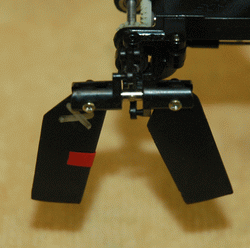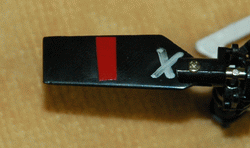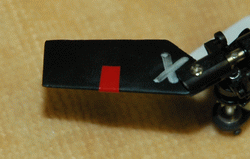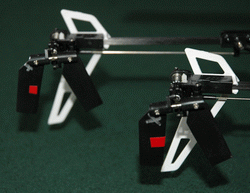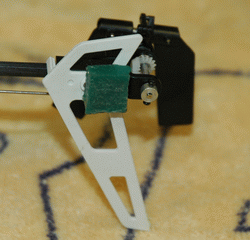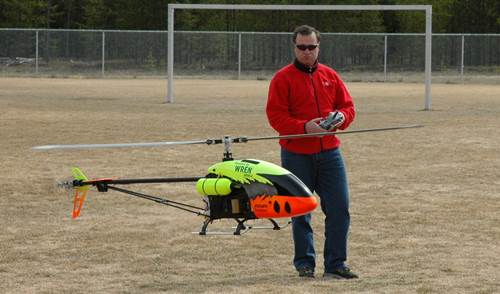Blade 130X Tail Vibration Fix
by John Salt
While spooling up, a good number of people are reporting 130X tail vibration issues. As I said in my 130X review, I have experienced this as well on my 130X.
To be perfectly honest, I never really thought it was an issue since it was so short lived and by the time the rotors were up to flight speed, it was gone (mine phased in at about 17% throttle and was gone by 25% throttle).
I also had over a hundred flights on my 130X before doing anything about it and it was working fine the entire time.
Plus the fact most of my helis will have one or two tail resonances during spool up (not nearly as strong as the 130's mind you) pretty much made me insensitive to the problem.
I guess that was
Horizon's stance as well from the feedback I was getting.
Anyways,
it wasn't until I was contacted by a few people with vibration
questions and also heard hobby shops were having a fair number of 130X
returns due to excessive 130X tail vibrations that I started to take this
problem a little more seriously and started playing around with possible
fixes.
I honestly didn't have time for this, but I was getting rather
annoyed by all this negativity over such a great little micro heli. Yes,
at the end of the day this is still a low cost, micro size heli, so really
how much should we expect? As it turns out, more than I thought...
Identifying The 130X Tail Vibration
Before
getting into the fix, I thought I should go over the vibration
characteristics, how to identify them, and what damage they can actually
do.
The 130X's visible
tail vibration is transitional in nature; by that I mean it's not there
all the time (or at least it's not visible all the time).
The visual vibration we actually see is a resonance vibration that builds in amplitude at a very specific tail RPM/frequency.
Essentially what happens is at a certain tail RPM, the tail vibration frequency matches the natural frequency of the tail boom along it's length wise axis and at that point, the tail boom will resonate/oscillate along its torsional axis.
If you look at the 130X's tail case block end on while it's
resonating, you will see the entire tail case and tail shaft oscillating
up and down in a twisting blur/buzz along the torsional axis of the boom
when the resonance peaks.
So
why does it do this? From my experience and others, it's a simple tail
rotor blade imbalance issue. Basically the vibration is there all the
time, but only at that specific frequency does it set up the harmonic
resonance in the tail boom, and then it's hard to miss or ignore.
I have
read some reports this is caused by tail shaft hubs that are not
aligned correctly on the shaft, but I have yet to see it first hand. Still, it's something to check for first since the best balancing job will be meaningless if the hub is not sitting at a right angle to the shaft.
I
have also heard people saying the stock tail bearings are garbage, but
again, is that factual evidence from actual bearing failures, or is the
excessive resonance if allowed to occur for extended periods taking out
the tail bearings prematurely?
Like I mentioned, I had over a hundred flights on my 130X
with not much bearing play increase at all because I quickly ran through
the resonance every time I spooled up. That said, even if you run
through that harmonic resonance quickly, the underlying tail blade
imbalance and short lived resonance each time you spool up will
certainly cause premature bearing failure over time.
There
are better bearings available - no question there, but even higher end
bearings will fail faster if the blade imbalance is
not corrected first. In fact, when I replaced the tail shaft bearings
with better ones before balancing the tail blades, the resonance got
even worse (higher in amplitude) due to the fact the little bit of slop
that had developed in the stock bearings was absorbing some of the
vibration energy so it couldn't build in amplitude as strongly as it
could with the new bearings that had next to no slop.
Here is what the tail vibration will look and sound like as it phases in and out of resonance (poor little tail bearings).
130X Tail Vibration Fix
As
I said in the 130X review, the fix is so simple and easy... The other
great thing is that the resonating tail boom is actually the best tool
we have for determining when the tail blades are in dynamic balance. If
the tail boom never resonated after all, chances are we would never know
the tail blades were not in dynamic balance. Who knows, perhaps it was
engineered that way so we all could balance our tail blades correctly?
Okay, not likely but I like to look at the glass half full and see this
as a benefit to be used to our advantage.
To
dynamically balance the 130X tail blades, just pick one blade and put a
small piece of electrical tape on it. About 4mm X 10mm seems to be a good size
to start with about mid way lengthwise on the tail blade. Mid way seems
to work best because it's roughly at the lengthwise center of gravity
of the blade and won't upset the lead/lag characteristics of the tail
blades that much. Speaking of lead/lag - DON'T over tighten the tail
blade grip screws.
The blades have to remain fairly loose in the grips (loose enough they hang down under gravities influence) so they can lead and lag properly. If they are too tight, you will introduce lead/lag oscillations as well to the tail or prolong and increase the amplitude of the resonance through a broader RPM range.
Now
spool up your 130X into that resonance sweet spot and see what happens,
did it get worse or better? If it got worse or made little impact, move
the tape to the other blade and try again. It should have gotten better
now if this was in fact a blade balance issue.
Once I find which blade the tape helps to reduce the vibration, I will mark it somehow so I know which blade gets the tape from here on in.
I just used a silver permanent marker to illustrate this with an "X", you can certainly be more subtle in blade identification.
Now it's fine tuning time. Perhaps that 4mm X 10mm tape totally eliminated the vibration if you are really lucky and hang out with magical leprechauns; but in the real world, you are going to have to play around with the size a bit to get the dynamic balance perfect.
Just experiment with different sizes of tape until you get it as good as possible. You should be able to reduce it to the point you will only see a slight vibration in the bottom half of the tail fin, but no more torsional oscillations should be evident on the tail case block or tail rotor shaft.
Once you have the size of tape you need, you might want to record that somewhere so if the tape goes flying off the blade, you know what size to make its replacement.
It also greatly helps after you determine what size, to place the tape over the leading edge of the blade so it's less likely to come off. I used red tape here to help see it better in the photo, but black or clear tape can be used if you wish to have a more "invisible" balance job.
TIP:
My second Blade 130X didn't have much tail vibration at all and was in pretty good balance out of the box, but there was just the shortest lived resonance that I wanted to see if I could eliminate. This makes it much harder to find which blade is lighter and heavier since they are both so close in balance.
If your 130X has very little vibration, but it's still enough to visually cause the tail shaft to "blur" for a brief moment, use a smaller piece of tape to start with. If you start out with a larger 4mm X 10mm piece, the vibration will get worse no matter what blade you put it on since you are throwing the balance out so much regarless of what blade you pick first.
As you can see, the 130X tail in the background needed a much smaller piece (about 4mm x 4mm) to dynamically balance the tail. A piece this small won't stick well! I had to use a larger piece of clear Scotch Tape (which is lighter than electrical tape) so I could wrap it over the leading edge.
Again I only used the red tape for visual purposes in the photos - if you have very little vibration to start with, you are likely better off using clear Scotch tape from the get go...
The other (better) option, which I will try next (due to the very small amount of mass needed to balance this blade set), is to remove a little blade material on the opposite (heavy blade). A little sand paper work on the end tip of the blade and keep testing until the resonance is gone.
Adding A Dampening Mass
After
you get the blade balance as good as possible, if you are really fussy
and wish to absorb any slight remaining resonance, you can add a simple
dampening mass.
Here I have just placed a small cube of Zeal tape (an almost Jell-O like gyro mounting tape with excellent vibration absorption qualities) on the tail fin in line with the axis of the tail boom.
This small dampening mass totally eliminated any remaining tail vibration to the point even the bottom tip of the tail fin won't vibrate as the tail RPM passes through the resonance frequency.
Yes, it's ugly as hell and a little excessive, but I just wanted to mention it and throw the idea out there. No doubt there are better and more attractive ways to add a dampening device to the 130X's tail; so all you budding mechanical engineers, go to town on that one if you wish.
Better Bearings For The 130X
The stock tail shaft bearings should last a fairly long time if you fix most of the vibration early on. That said, if and when you notice your tail shaft bearings (or any other bearings on your 130X for that matter) are starting to develop a fair amount of lateral runout and play, there is a very nice little 130X bearing upgrade kit from Boca Bearings for only $30 bucks.
Definitely better bearings over the stock ones and I've
been very happy with them on my 130X and will definitely be ordering a
another set for my second 130X when the time comes.
Boca
also has the 1.5mm x 4.0 mm x 2.0 flanged tail shaft bearings separate if you just wanted to get the tail shaft bearings individually for $9 bucks each (the whole kit as you can see is a much better value).
Lastly, if you want the best quality bearings you can put in the tail, Boca has a full stainless steel flanged SMF681X-ZZ 1.5 x 4 x 2 bearing. A little more money than the chrome steel ones, but they should last a little longer.
Hope something in here helps cure your 130X tail vibrations should you have them, or at least give you a few ideas to try yourself :-)

